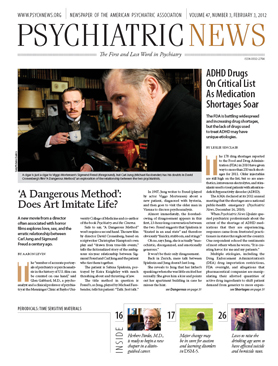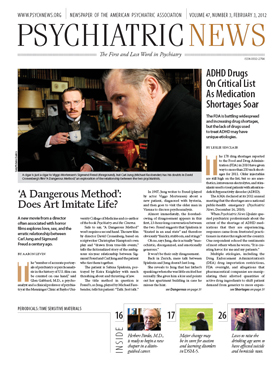A single diagnostic entity— autism spectrum disorder—is being proposed for inclusion in DSM-5 as a replacement for the three autism diagnoses listed in DSM-IV.
That proposed change—eliminating the diagnoses of autism, Asperger’s disorder, and pervasive developmental disorder–not otherwise specified—(PDD-NOS) is the most dramatic, and possibly controversial, in store for the chapter on neurodevelopmental disorders in the revised manual to be published in 2013. Other major changes include the addition of several language-related disorders and a category to be called “specific learning disorder” with seven “descriptive feature specifiers” that would be used by clinicians in the diagnosis of patients with learning disorders in specific areas (see
New Learning Disorder Diagnosis Proposed at http://psychnews.psychiatryonline.org/newsArticle.aspx?articleid=481202).
Also proposed are changes to the criteria for intellectual development disorder, known in DSM-IV as mental retardation.
Susan Swedo, M.D., chair of the DSM-5 Neurodevelopmental Disorders (ND) Work Group, told Psychiatric News that much recent research has indicated a lack of concordance across clinical centers treating autism in how the three diagnoses in DSM-IV have been used and how the criteria have been applied.
For instance, a recent large multisite study in the
Archives of General Psychiatry (November 2011) found significant site differences in “best-estimate clinical diagnoses” of specific autism spectrum disorders (ASD). Moreover, relationships between clinical diagnoses and standardized scores, particularly verbal IQ, language level, and core diagnostic features, varied across sites in weighting of information and threshold cutoffs (see
Extensive Variations Found in Making Autism Diagnoses at http://psychnews.psychiatryonline.org/newsArticle.aspx?articleid=481203).
“The DSM-5 ND work group spent a great deal of time evaluating the reliability and validity of the separate ASD diagnoses and concluded that there was no evidence to support continued separation of the diagnoses,” Swedo told Psychiatric News. “That is why we’ll be recommending that DSM-5 utilize a single diagnosis—autism spectrum disorder.”
Swedo said the subsuming of Asperger’s within the broad category of ASD has been the biggest area of attention for public and professional comment.
Family and patient responses to the subsuming of Asperger’s into ASD were not tepid and included those who strongly protest the change as well as those who hail it.
Swedo said a small but vocal group of adult patients identify themselves as having Asperger’s and seek to have the condition recognized for its impairments, but also for its strengths. These adults, some of whom refer to themselves as “Aspies,” find representation in Web sites such as Aspie.com and registered vehement opposition to being “lumped in” with individuals with autism, she said.
But Swedo responds that the definition by which many of these adults identify themselves did not meet the criteria for Asperger’s as indicated in DSM-IV anyway. “Our response is that they may continue to self-identify according to their own definition,” she said.
She added that another group composed of parents of children who meet the DSM-IV criteria for Asperger’s expressed concern that the change would mean their children’s unique needs would go unrecognized.
But Swedo told Psychiatric News that the same child diagnosed with Asperger’s in one clinic would as likely be diagnosed with autism in another. “The improvement we are proposing for DSM-5 is to have specifiers in place that allow us to identify for other clinicians the differences presented by individual patients.”
Finally, Swedo said a fairly large group that registered loud applause for the change is composed of parents and family members residing in states—such as California—where services are reimbursed for autism but not for Asperger’s or PDD-NOS.
“I was grateful that we had data to back up this proposed change,” Swedo said. “It was a thoughtful exchange. We had started out trying to develop criteria that would better separate out these groups, but the data indicate that there is no discernible difference.
“I suspect our recommended changes have struck the right balance between ‘lumping and splitting’,” she said. “We get an equal number of clinicians concerned that the new ASD category is too broad and those who think it is too narrow. It’s a reminder that DSM is a manual of behavioral disorders that are diagnosed by observation, and those observations will always be influenced by a clinician’s training and previous experience.”
Language Disorders May Be Primary
Also noteworthy is the work group’s proposal to add a group of “communication disorders” including four new language-related disorders that did not appear in DSM-IV. Those are language impairment, late language emergence, specific language impairment, and social communication impairment.
Swedo said that for recommendations about development of criteria for the disorders, the work group relied on an advisory group from the American Speech-Language-Hearing Association. She said the proposed criteria would bring DSM into concordance with ICD-10, as well as with diagnostic categories used by American speech and language professionals.
Language impairment would be diagnosed based on language abilities that are below age expectations and persist into adolescence and adulthood; the impairment can affect the domains of vocabulary, grammar, narrative, expository, and conversational discourse and other pragmatic language abilities individually or in any combination.
“If language impairment is present, it should be determined whether the criteria are met for late-language emergence, specific language impairment, or social communication disorder in order to formulate appropriate diagnostic testing and treatment plans,” Swedo said. “Language impairment [LI] may be a provisional diagnosis to initiate treatment and further investigation. Or it may be the primary diagnosis if criteria are not met for any of the other LI diagnostic categories.”
Symptoms Resemble Autism
She told Psychiatric News that the work group was especially invested in development of criteria for social communication disorder because its symptoms are similar to those of autism; symptoms include impairments in communication identical to those exhibited by patients who would now be diagnosed with autism spectrum disorder, but without the restrictive and repetitive behaviors characteristic of ASD.
“We believe the social communication disorder will capture those patients who have in the past been diagnosed with pervasive developmental disorder-NOS as a way of bringing attention to the patient’s social communication impairments despite the absence of restricted interests and repetitive behaviors,” she said.
Any of the language disorders may represent symptoms that have in the past been diagnosed otherwise. “We hope this reminds clinicians that language disorders can be primary,” Swedo said. “A child might look like he or she has social phobia, but may in fact have a language disorder.”
Significant changes have also been proposed for intellectual development disorder, formerly known as mental retardation. Swedo noted that the name change would align DSM with international usage and with terminology used by U.S. professionals specializing in intellectual development disorder.
Most prominent is the fact that according to the proposed criteria, diagnosis would not be based solely on standardized IQ testing but would also require impairments in “adaptive behaviors,” typically measured using individualized, standardized, culturally appropriate, psychometrically sound tests.
Swedo explained that tests of functionality have increasingly replaced IQ tests. “IQ has turned intelligence into this fixed entity that has become very problematic diagnostically,” she said. “Forensic psychiatrists, for instance, have had to assess someone having an IQ of, say, 71 as not having an intellectual development disorder and thereby eligible for the death penalty. Moving away from a specific number and incorporating functional testing is going to be very helpful to clinicians in matching diagnosis to individual patients.”

